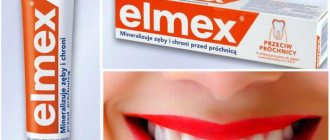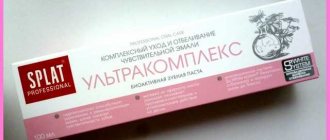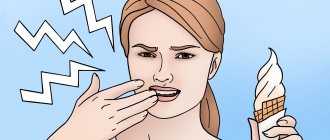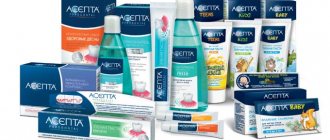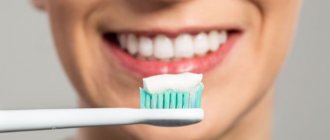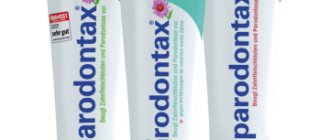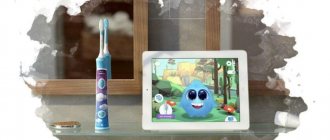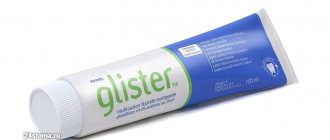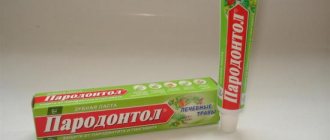Description
Colgate Elmex Kids paste is produced by Colgate in Poland. The product is white in color and has a minty taste and smell. Packaged in soft plastic bottles of 50 ml. The bottle is sealed with plastic and opens with a key located at the end. The lid can be unscrewed, but it is large and the tube can be placed on it if desired. The container is placed in a cardboard box on which a mouse is drawn and all the information about the manufacturer and product is indicated.
On a note!
The formula contains substances that prevent the appearance of plaque and the development of inflammatory processes in the gums. The product perfectly refreshes the oral cavity and prevents dental diseases at the developmental stage of up to 6 years.
Compound:
- water molecules;
- sorbitol;
- hydrated type silica;
- hydroxyethylcellulose;
- CI 77891;
- cocamidopropyl;
- betaine;
- olaflur;
- flavoring and limonene;
- saccharin.
The content of unique amino fluoride in Elmex children's toothpaste ensures the formation of a protective fluoride layer on the enamel surface of the teeth. This makes them more resistant to the loss of minerals and prevents the development of carious destruction. Aminofluoride also helps remineralize dental tissue.
On a note!
The series also includes a Colgate Elmex Junior option, which is intended for children from 6 to 12 years old.
Advantages and properties of Elmex toothpaste
This brand appeared in 1962 and very quickly became popular not only among buyers, but also among specialists - dentists, who began to more often recommend Elmex paste to their patients.
There are five varieties of Elmex , each with its own characteristics and can be used to correct specific problems in the mouth.
All of them belong to the type of therapeutic and prophylactic agents . The company produces products for children and adults, so the whole family can carefully and thoroughly care for their oral cavity, maintaining the health and beauty of their smile.
The advantages of these pastes:
- high quality;
- well selected components;
- elimination of inflammatory processes in the gums and bleeding;
- decreased sensitivity and strengthened enamel;
- use of innovative solutions in the production.
Manufacturers of Elmex oral care products
The GABA group of companies has been operating for over a hundred years.
It also owns brands such as Meridol and Colgate. It all started with an ordinary pharmacy, but now this structure is a world leader in the production of such oral care products: toothpastes; rinse aids; toothbrushes and floss. The homeland of the company is Switzerland , however, factories are located in different European countries:
- Italy.
- Germany.
- Austria.
- France.
As for the Elmex brand, this toothpaste immediately after its appearance on the market established itself as an excellent remedy for caries . It also helps with the following:
- Eliminates dental plaque.
- Protects the area near the roots from negative influences.
- Freshens breath.
- Prevents the appearance of tartar.
Reviews
Reviews of Elmex children's paste indicate the need to consult a dentist before using the product.
My child's teeth were covered with yellow plaque, and when I started researching how to get rid of it, I found information about Elmex from Colgate. The product turned out to be not very expensive, so I decided to try it. I noticed the first results within a week; tooth enamel became significantly whiter. At first, my son didn’t like the taste of the paste, but after a few cleanings he got used to it. We consulted with the dentist, and he approved of our choice, but advised us to alternate with a product without fluoride in the composition.
Elena, Moscow
Our dentist recommended Elmex paste from Colgate because of weak tooth enamel. We have been cleaning it for a long time, and there is a positive result noted by a specialist. Your teeth have become not only more beautiful, but also much healthier. This is an excellent remedy for us, but since it contains fluoride, I cannot recommend it to everyone without consulting a doctor. Only a specialist can choose the right care products.
Olga, Voronezh
Mode of application
To achieve maximum effect, you should follow the rules:
- brush your teeth at least 2 times a day;
- apply a small pea-sized amount of gel;
- carefully treat the inner surface of the distant teeth;
- The cleansing procedure should last 2-3 minutes.
Recommended method of use: apply a small amount of paste to the brush. You should clean your teeth in a circular motion, additionally massaging your gums to improve blood circulation. After finishing, you need to rinse your mouth with clean water several times, holding it for 5-10 seconds.
Note! The paste is not a medicine. To prevent dental diseases, it is necessary to undergo preventive examinations 1-2 times a year.
Analogs
Other manufacturers also produce children's toothpaste:
- Lyon Xilident kids. Made in Lyon, Japan. Contains fluorine and has reduced foaming. The cost is about 390 rubles.
- Weleda Children's tooth gel. Produced in Germany. Price – 395 rubles.
- Asepta Kids. Gel for children from the Russian manufacturer Vertex. Cost – 194 rubles.
- President Baby from Betapharma (Italy). Designed for ages up to 3 years. Price – 132 rubles for 30 ml.
How to choose the right toothpaste for children?
Visually, children's toothpastes are very easy to distinguish from adult toothpastes - they have beautiful, brightly designed packaging. Pastes for children are more tasty, which in some cases helps to avoid the gag reflex. How to make the right choice?
First, you need to understand that toothpastes for adults or so-called toothpastes for the whole family are not suitable for children if the child is under 14 years old.
Despite the fact that they contain the same components, their “adult” concentration can be dangerous for a child’s body. Therefore, the first and simplest guideline when choosing a toothpaste will be the child’s age.
Since at this stage children are transitioning from baby teeth to molars, the paste should take into account the characteristics of both. Ideally, it will reduce the risk of caries, as well as reduce the discomfort in children associated with changing teeth.
Toothpaste for little ones should provide gentle but high-quality cleaning of baby teeth. Therefore, its RDA abrasiveness index cannot exceed 20 conventional units. Children's paste should be safe if accidentally swallowed, since small children have not yet learned to properly rinse their mouths and about 30% of the contents of the tube are simply eaten. The concentration of fluoride in children's toothpastes of this age category is maximally reduced (no more than 500 ppm), or it is absent altogether.
The RDA abrasiveness index is already higher, but not more than 50 conventional units - brushing your teeth should be soft and not injure young enamel. The fluoride content in toothpastes of this category does not exceed 1000 ppm.
Having decided on the age category in which the paste should be selected, we move on to the most important thing - carefully study the composition.
At this age, children's molars are already beginning to predominate, so in pastes of this category the fluoride content is close to the composition of adult pastes - about 1400 ppm. The abrasiveness index, as in pastes from 4 to 8, does not exceed 50 units.
- Abrasives
As we have already understood, toothpaste for children should provide gentle but high-quality cleaning of milk and molars. Therefore, we pay attention to what kind of abrasive it contains.Calcium carbonate or sodium bicarbonate, in other words, chalk and soda. These substances are aggressive and can cause significant damage to the enamel.
Preference should be given to pastes that use titanium dioxide or silicon dioxide as an abrasive - the least traumatic and most effective substances. Unfortunately, not all manufacturers indicate the degree of abrasiveness. On the Russian market, the RDA indicator can be found on tubes of President and ROCS pastes
- With or without fluoride?
As a rule, toothpastes with fluoride (for example Lacalut) are recommended for children living in areas with low levels of this element in drinking water.For our region, the presence of fluoride in toothpaste is mandatory.
But in some districts of Chuvashia, the fluoride content in drinking water is exceeded - in Komsomolsky, Morgaushsky, Krasnochetaysky, Krasnoarmeysky. These areas are characterized by a disease called fluorosis.
In other regions of Chuvashia, in Cheboksary, in particular, fluorine in drinking water is 0.1 micrograms per liter, but it should be no less than 0.9-1.2.
Therefore, we must have toothpaste with fluoride ions.
Before buying toothpaste with fluoride, consult your doctor, who will recommend a toothpaste depending on the degree of caries activity and the age of the child.
- Antibacterial substances
The main antibacterial substances used in toothpastes are triclosan, metronidazole and chlorhexidine. The problem is that they kill not only harmful bacteria, but also beneficial ones, thereby disrupting the microflora of the oral cavity. You can use toothpaste with these substances only on the recommendation and under the strict supervision of a doctor.
- Foaming substances
The main functions of foaming substances are to wet the tooth surface, foam and influence the uniform consistency of the paste, which ultimately facilitates the process of brushing teeth. The most famous foaming agent that is added to various hygiene products is sodium lauryl sulfate (SLS, E 487). Unfortunately, the benefits from it are much less than the harm. This substance has a toxic effect, dries out the oral mucosa, and can also cause a severe allergic reaction and other negative consequences. An alternative is sodium laureth sulfate (SLS), which is less irritating. In general, foam as such does not greatly affect the process of cleaning teeth, so it is advisable to choose a children’s toothpaste that is at least without sodium lauryl sulfate. - Preservatives
Preservatives are added to toothpastes in order to block the development of microflora in it during transportation, storage or use. Here it is worth checking the composition for the presence of sodium benzoate, which at increased doses is a strong carcinogen, prohibited for use in some countries. Propylene glycol (may appear as PEG or PEG), better known as a de-icing agent, is also very harmful to health. Avoid toothpastes with propylparaben, a harmful carcinogen. - Flavoring fillers
Flavoring fillers are used in pastes to remove the effect of the unpleasant taste of individual substances included in its composition. They give the pasta a pleasant taste. For this, menthol, various varieties of mint, anise, eucalyptus, vanillin are used, as well as sweeteners such as saccharin that do not stimulate the development of caries. Moreover, it is worth adding that some components of the pastes can perform several functions - simultaneously acting as, for example, a sweetener and a flavoring agent. In general, the presence of saccharin and artificial colors in the recipe is undesirable. - Useful material
But what should be in a high-quality toothpaste for children are milk enzymes: lactoferrin, lactoperoxidase, lysozyme, glucose oxide - all of them help strengthen the baby’s immunity and enhance the protective properties of saliva.Natural protein casein is also added to children's pastes, which contribute to the accumulation of calcium in the enamel layers.
If the paste contains a small percentage of fluoride, then it must be present in organic form - this component is prescribed in the composition as olaflur or aminofluoride. Xylitol is a natural ingredient found in the fibers of fruits and vegetables that has been shown in clinical studies to reduce the risk of dental caries and microbial biofilm on teeth.
Summarize:
In children after 1 year, if carious lesions often appear, it is necessary to use pastes with fluoride (preferably with aminofluoride or olaflur). The European Society of Dentistry openly speaks about the safety of fluoride toothpastes in children from 1 to 6 years old (in dosages of 250-1000 ppm). And he recommends the use of such pastes in children who regularly develop new carious lesions.
The main thing is that the pastes do not contain sodium lauryl sulfate (SLS), calcium carbonate or sodium bicarbonate, triclosan, metronidazole and chlorhexidine, thickeners of chemical origin - derivatives of cellulose, acrylic acid, sodium benzoate, propylene glycol (PEG), propylparaben, the presence of saccharin and artificial dyes are not recommended.
Some toothpastes for children contain both fluoride and calcium. It is better to avoid such toothpastes, because... fluorine and calcium, being in the same tube, begin to bind with each other into an insoluble salt, calcium fluoride, which does not have any positive effect on the teeth.
If a child regularly experiences stomatitis of the oral mucosa, then it is best to use toothpastes containing a complex of enzymes (lactoferrin, lactoperoxidase, lysozyme, glucose oxidase), which increase local immunity in the oral cavity.
Toothpaste is an essential hygiene product for children's teeth, but its role in the prevention of caries in children is often greatly exaggerated. Regular and high-quality oral hygiene in children, preventive dental examinations and proper nutrition are much more important here. Choose a toothpaste with the most natural, simple composition, and it is best to buy it in a pharmacy or specialty store.
Safe children's toothpastes:
- Children's tooth gel with calendula Weleda from 0-5 years. Hypoallergenic.
- Aquafresh toothpaste “My first tooth from 0-2 years” sodium fluoride content 500ppm
- Aquafresh toothpaste “My baby teeth from 3-5 years old” sodium fluoride content 500ppm
- Splat Junior toothpaste from 0-4 years contraindication milk intolerance (contains casein)
- Splat toothpaste from 3-8 years
- Toothpaste Splat Juicy Set
- Colgate ELMEX toothpaste from 1 tooth to 6 years contains 500 ppm amino fluoride.
- Colgate ELMEX Junior toothpaste for ages 6-12 contains 1400 ppm amino fluoride.
- Splat Juicy Set Toothpaste.
- Aquafresh toothpaste “My big teeth 6+” sodium fluoride content 1450ppm.
Fluoride in children's toothpastes: is it dangerous?
In many places you can see information that a substance such as fluoride is highly not recommended for use in toothpastes for small children, since it can cause harm to health if the child swallows the paste while brushing their teeth. In European countries, serious long-term studies were carried out, during which it was found that the fluorine content in toothpaste in a concentration of up to 500 ppm is not capable of causing harm to the health of children.
In Europe, the position on adding fluoride to children's toothpastes was revised more than 10 years ago. Fluorine is not so much dangerous as the various dyes and preservatives added to many toothpastes in order to improve their qualities. Russian dentists share the same opinion, however, it is not so easy to get rid of the information that was put into people’s heads many years ago and is erroneous. If the question arises: “Should I choose a toothpaste for my child with fluoride or calcium?” — you should be guided not by the harm they cause (both substances are safe), but by the age of the baby and the current condition of his gums and teeth.
Rumors regarding the harm of fluoride in toothpastes are fueled from time to time on various forums, where mainly mothers gather who do not understand medicine and do not follow discoveries in this area. In addition, such information is beneficial to manufacturers of pastes containing calcium. Even messages left on the same forums are often hidden and skillfully implemented paid advertising. Its goal is to harm competitors and increase its own sales.
